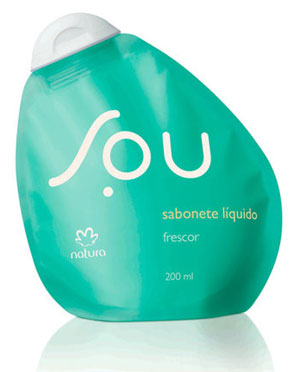
2014-02-16 21:58:53
The Shift from Rigid to Flexible Packaging in the Personal Care Industry
2014-02-16 21:58:53
Smithers Pira looks at four possible advantages.
 Brazilian manufacturer Natura Cosméticos chose flexible packages for its personal care brand, Sou. |
The way in which consumers view and interact with packaged products is changing.
With a growing focus onconvenience and sustainability,traditional pack types are being replaced by innovative and flexible options designed to meet these consumer needs, particularly in the personal care market.
Flexible packaging currently has an8.8% market share in this sector, trailing behind rigid plastic packaging which occupies 52.2%.
However, many new opportunities for flexible packaging are presenting themselves and there are also many benefits associated with this type of technology.
So, what is it exactly that sets flexible packaging apart from more traditional rigid alternatives?
In this exclusive bulletin, Smithers Pira examines the main advantages of flexible packaging over more traditional rigid packaging solutions.
1.Environmentally-friendly
Sustainability has become one of the most important trends in many sectors, especially the personal care market, and some brand owners are replacing rigid packaging with flexible alternatives in order to reduce their carbon emissions.
In particular, companies with an emphasis on natural and eco-friendly products can improve the appeal to their consumer base and attract new customers through more sustainable packaging solutions.
One example of such a company is Natura Cosmeticos, a leader in direct sales of cosmetics in Brazil, who have presented a new line of personal care products called Sou.
Sou has lower prices than similar items in the brand’s portfolio, and comprises 27 products – ranging from liquid soaps and moisturizing creams to shampoos and hair conditioners.
All items are presented in innovative 6.7oz stand-up pouches with a tear-drop shape, sealed with a flip-top cap.
According to Natura Cosmeticos, the flexible packs require 70% less plastic than rigid plastic containers of the same volume.
Natura also claims that a roll with 1,000 pouches occupies the same truck space as 28 empty bottles, marking a 60% reduction in carbon emissionsand evidencing the potential of flexible packaging to fulfil sustainability concerns.
2. Lightweighting
A key trend for flexible packaging of personal care products over the forecast period will be the continued down-gauging as the combination of environmental pressures and high raw material prices make customers demand even thinner and less costly packaging.
In many sectors, materials have gotten lighter and lighter over time, producing less waste. Therefore, the next step in this process is to replace rigid materials with lightweight, flexible pouches.
This development has been gaining traction over the years, although widespread usage has not yet occurred. The primary reason for this has been issues with high-speed filling – while PET bottles can be filled at speeds of 1,500 packages per minute, the process of filling pouches falls behind at only 400 packages per minute.
However, some of the newer PET bottle-filling technologies are designed to transport the bottle through the cycle via the neck, a breakthrough which will also allow the introduction of pouches using the same technology.
This is forecast to occur as early as 2014, and the use of pouches would allow water companies to reduce their packaging weight by 50%.
3. Barrier properties
Performance properties of flexible packaging can be easily tailored to meet demanding specifications for a wider range of products.
Indeed, the flexible packaging market has developed over the years from simple paper wrapping and bags to often very sophisticated, multi-layer and multi-material products offering product protection, barrier protection and shelf-life extension.
Flexible plastic packaging for many cosmetics and toiletry products tends to be of a relatively low specification. These include over-wrap for toilet tissue, wipes and sanitary products, BOPP monolayer webs and laminates for wrapping soap and toothbrushes for overwrapping cartons of perfume, cosmetics and men’s toiletries.
However, more sophisticated cosmetics such as special oils, vitamins and herbal compounds need greater protection from light and contamination. They may also need to last a longer time on the shelf and after purchase.
A wide variety of flexible and multi-layer barrier packaging films are used, often incorporating aluminum foil.
The main attributes of aluminum foil as a flexible packaging material for personal care packaging are its barrier properties. Foil does not absorb water and grease, it has a good dead-fold, plus good formability and machinability which all lead to greater protection of the product.
4. Packaging variation and convenient dispensation
As more of us live independent lifestyles and are constantly on the go, there has become a requirement for products that are easier to carry and use when on the move.
This desire for smaller and thinner packs is evidenced from the prominence of single-use sachets and innovative re-closable packs.
This move toward convenience and single-use suggests that the use of flexible packaging and other lightweight solutions will continue to grow.
Packages made from flexible plastic films can be made into practically any shape imaginable, and the inclusion of handles, fitments and opening features is quite straightforward. Today’s pouches often have advanced dispensing functions such as screw-top caps and laser-scored tear features.
Flexible packaging can also be used to enhance rigid packs; an example being shrink labels used for plastic bottles. These labels not only provide attractive decoration features, but also additional levels of barrier protection against oxygen or light.
Dispensing systems have become a key way for brands to differentiate products and offer consumers additional value.Brands are introducing products with dispensing applicator tips that directly apply formulas to the face or other target area, and flexible packaging has lent itself well to the new development.
Aptar’s applicator Caresse, for example, is a bi-injected, flexible applicator that works like a fingertip, providing as gentle application that massages the skin.
For more information onThe Future of Global Flexible Packaging to 2018, contact Bill Allen at Smithers Pira.
LinkedIn




